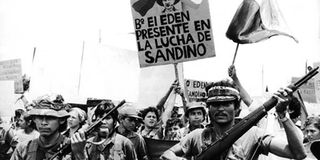Prime
Reflections on the Nicaraguan Revolution of 1979

On January 10, 1978, the assassination of the leader of the opposition Democratic Liberation Union, Pedro Joaquin Chamorro, triggered a nationwide strike in Nicaragua. FILE PHOTO
What you need to know:
Back in time. Recollection of the circumstances that led to the fall of the Somoza Junta are food for thought on the post-Idi Amin Uganda of the late 20th Century, to the present day 21st Century and new millennium, Emmanuel N. Mukanga writes.
There is a saying that ‘history keeps on repeating itself’, on the one hand, and on the other hand that, ‘the one thing we learn from history is that, we learn nothing from history’.
Thirty-eight years ago, on July 19, 1979, the world woke up to witness the end of the 43-year-old Somoza family rule in the Central American country of Nicaragua and the advent of the Sandinista government, under commandant Daniel Ortega.
Earlier that year, at home in Uganda, the government of ‘life president’ Idi Amin Dada, had crumbled after a blood-stained eight-year-rule that was brought to an end by a combined Tanzania People’s Defence Forces and a military expedition of Ugandan exiles.
Every year on July 19, hundreds of people from all over the country gather at Plaza La Fe (also known as Plaza de la Revolución) in Managua, the capital city, to commemorate the fall of the militarised Somoza family dictatorship.
This family ruled the country in a harsh and unscrupulous way for more than four decades. The dynasty was overthrown after the National Sandinista Revolution, which took place when people from all sectors – workers, businessmen, peasants, students, and guerrillas – joined forces and finally defeated the Somoza dynasty and the National Guard on July 19, 1979.
Recollection of the circumstances that led to the fall of the Somoza Junta are food for thought on the post-Idi Amin Uganda of the late 20th Century, to the present day 21st Century and new millennium.
The Sandinistas
The Sandinistas took their name from Augusto César Sandino (1895–1934), the charismatic leader of Nicaragua’s nationalist rebellion against the US occupation of the country during the early 20th Century.
Sandino was assassinated in 1934 by the Nicaraguan National Guard, the US-equipped police force of Anastasio Somoza, whose family ruled the country from 1936 until they were overthrown by the Sandinistas in 1979.
Anastacio Somoza García, a national military man trained in the United States took power in 1936. His unconditional alliance with the United States (with whom he negotiated at the country’s expense) and his complete control of the National Guard guaranteed him his totalitarian “throne”, where opposition politicians were controlled using terror methods and sometimes by massive executions.
In September 1956, Rigoberto López Pérez, a young poet shot the dictator during a social celebration that took place in the city of León. Rigoberto was killed at the same place, while Somoza died later in a Panamanian hospital.
Somoza García’s oldest son Luís Somoza then took over the presidency, while the National Guard was led by the youngest son, Anastacio Somoza Debayle, who started a repression movement in León after his father’s death, against those who he considered political enemies.
In 1967, Luis Somoza Debayle suddenly died and was replaced by an interim president until his younger brother won the national elections and restored the dictatorial, repressive and devouring regime.
Even though his father had acquired various real estate properties, businesses and industries that then became his and his family’s patrimony, Somoza Debayle continued to indiscriminately collect more and more wealth.
At the end of 1972, when an earthquake hit and devastated Managua, a big part of foreign aid brought to Nicaragua was deviated to the dictator’s warehouse. This aid was commercialised and auctions put in place for the reconstruction of the city (paid by public money and international aid) were won by Somoza’s businesses and their allies.
The social distress was increasing, but the National Guard could strongly submit any public declaration by torturing and executing political opponents and people from the general population.
In 1969, a small group of battlers, hidden in a house in Managua, was discovered by the National Guard, and a battle took place, almost as if it was a movie scene. Three hundred soldiers, tanks and planes were sent to destroy the hidden guerrillas.
The battle lasted several hours until there was no more answer to the attack. When soldiers entered the house, seeking for bodies, they realised that the entire combat was fought by a single young man, Julio Buitrago, who stayed inside the house so that his partners could escape.
Somoza showed the battle on TV to demonstrate the Sandinista National Liberation Front’s (FSLN) destruction, but the heroic action of a single man turned the entire situation around and the population was moved by the event and identified themselves even more with the revolutionary movement.
On January 10, 1978, the assassination of the leader of the opposition Democratic Liberation Union, and editor of the opposition newspaper La Prensa, Pedro Joaquin Chamorro, triggered a general strike and brought together moderates, the Roman Catholic Church and the Sandinistas in a united front against Mr Somoza.
Although his assassins were not identified at the time, evidence implicated president Somoza’s son and other members of the National Guard. Spontaneous riots followed in several cities, while the business community organised a general strike demanding Somoza’s resignation.
In August of the same year, 23 commandos led by Edén Pastora seized the entire Nicaraguan congress and took nearly 1,000 hostages, including Somoza’s nephew José Somoza Abrego and cousin Luis Pallais Debayle.
Somoza gave in to their demands and paid a $500,000 ransom, released 59 political prisoners, broadcast a communiqué with FSLN’s call for general insurrection and gave the guerrillas safe passage to Panama.
A few days later, six Nicaraguan cities rose in revolt. Armed youth took over the highland city of Matagalpa. Large numbers of semi-armed civilians joined the revolt and put the guard garrisons of four cities under siege. The September insurrection of 1978 was subdued at the cost of several thousand, mostly civilian, casualties.
In March, 1979 three parallel guerrilla groups concluded a unification agreement creating, in this way, a single FSLN, motivating the entire population to start an attack at the end of June.
In June, the guerrilla moved all its combatants in order to gather in Managua. A general strike was organised with the participation of workers and even businessmen, an indicator of hatred of the dictatorship in several cities.
‘Could not be stopped’
Although Somoza attacked those cities, killing many civilians, the FSLN, supported by the entire population, could not be stopped. One by one, each city was liberated from Somoza’s control.
Somoza’s previous ally, the United States, asked him to step down from power before a public downfall, and on July 17, Somoza, his collaborators, and leaders of the National Guard left the country, taking a huge fortune with them. Twenty four hours later, the National Guard finally surrendered.
On July 19, 1979, thousands of guerrillas and civilians entered the Plaza de la Republica, in the centre of Managua, where the population celebrated the fall of the Somoza dynasty. It was a national celebration and the opportunity to create a new Nicaragua.
Reforms started to be held to promote social justice at all levels. Banks were nationalised and properties were expropriated from the Somoza family and their allies.
As a sign of total victory a National Crusade of Alphabetisation was organised, reducing the illiteracy rate from 53 per cent to 12 per cent.
About the Sandinistas
The Sandinistas are the revolutionaries who toppled the Somoza dictatorship in Nicaragua in July 1979. In July 1961 Carlos Fonseca Amador, Tomás Borge, and Silvio Mayorga formed the Sandinista National Liberation Front. Their military actions in the 1960s were failures. In 1975 the Sandinistas divided into three ideological factions. The dominant Prolonged Popular War (GPP) faction was led by Fonseca, Borge, and Henry Ruíz. The Proletarian Tendency of Jaime Wheelock Román, Luis Carrión, and Carlos Nuñez rejected the GPP’s Maoist notion of voluntarism and focused on factory workers and barrio dwellers. The third (Tercerista) faction sought tactical alliances with businessmen, religious leaders, and professionals in 1977 and 1978.




